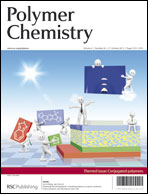Aqueous photocathode activity of regioregular poly(3-hexylthiophene)
Abstract
The aqueous photocathode activity of regioregular poly(3-hexylthiophene), a p-type organic semiconductor, is presented. Photocurrents up to 20 μA cm−2 under 100 mW cm−2 AM 1.5D irradiation were observed. The highest

- This article is part of the themed collection: Conjugated polymers

 Please wait while we load your content...
Please wait while we load your content...